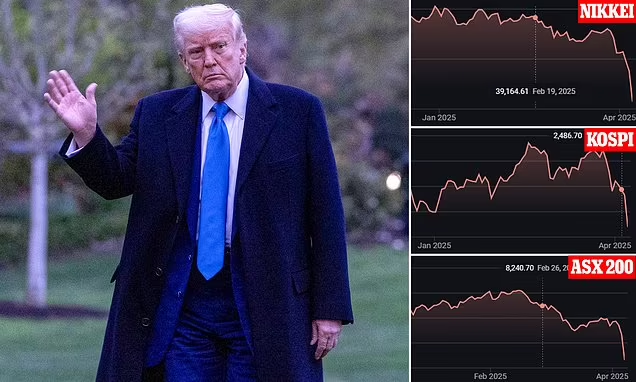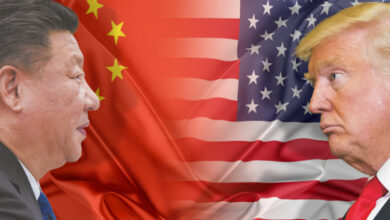From Chill To Chaos, Bear Market Goes Viral. Nifty Slides As Global Markets Spiral Into Freefall. 6 Brutal Reasons The Stock Market Just Crashed Like A House of Cards

Markets are in meltdown mode, Nifty tanks as global panic hits hard – Dalal Street woke up to a nightmare on Monday, one that had Wall Street’s fingerprints all over it.
The Sensex nosedived nearly 4,000 points at the open, cracking below 71,500, while the Nifty plunged over 4%, hitting a brutal low of 21,744. Just like that, Rs 19.4 lakh crore in investor wealth vanished into thin air, poof!
This was absolutely not an isolated downturn, it has instead morphed into a full-blown global market fever, and the symptoms are terrifying.
Wall Street is the epicenter, shaking from recession jitters and Donald Trump’s latest economic nuke – sweeping new tariffs that JPMorgan is calling the biggest U.S. tax hike since 1968. The investment giant has now pegged the probability of a U.S. recession at 60% and Traders are sweating bullets.
Stateside, the Nasdaq has officially entered bear territory, down 23% from its December highs. The Dow is limping behind with a 15% drop. Nifty, riding the same downward slide, is already off 17% from its September highs – just ~700 points away from bear market territory at 21,022.
But here is why we should not get ahead of ourselves, just because India’s caught less heat from Trump’s tariffs directly doesn’t mean we are in the clear. The contagion is real, and it’s here.
The U.S. Dollar Index is stumbling, 10-year Treasury yields have dipped below 4%, and Brent crude slipped to around $66 a barrel last week. Under normal circumstances, that combo, soft dollar, falling yields, and cheap oil, would be a dream for India – lower import bills, tame inflation, and a red carpet for FII inflows.
But the vibe isn’t normal anymore.
Jerome Powell is in no mood to calming nerves either as the Fed Chair dropped a cold truth bomb – the war on inflation is likely to “take longer than expected,” especially with Trump’s tariffs adding more fuel to the price fire. If U.S. inflation stays stubborn, hopes for rate cuts, the backbone of bullish bets, could go straight out the window.
Still, India’s macro scene still looks decently solid. Inflation’s mostly in check, the rupee is sound, and domestic-centric corporate earnings are holding steady. Some market strategists are even saying this is a ‘buy-the-dip’ moment, not a panic exit.
But sentiment is a fragile thing. And right now, it’s on the edge.
)
6 Brutal Reasons the Stock Market Just Crashed Like a House of Cards
1. Nasdaq Just Rang the Bear Bell
The tech-heavy Nasdaq officially belly-flopped into bear market territory, down over 20% from its recent peak. What triggered the chaos – Trump dropped a tariff bomb earlier this week, the kind that rattled global trade nerves. The scale was unexpected, and the impact massive. Fed Chair Jerome Powell looked rattled, calling the tariffs “larger than expected” and warning they could wreck both inflation control and economic growth. Investors hit the panic button and fast!
2. Global Selloff, It’s Contagious
Not only Wall Street but markets worldwide caught the fever. Asia melted down – Japan’s Nikkei fell 7%, South Korea’s Kospi dropped 5%, and China’s blue-chip index crumbled nearly 7%. The Hang Seng slammed over 10.5%. Meanwhile, U.S. futures continued to tank – Nasdaq futures were down another 4%, and the S&P 500 futures fell 3.1%.
Europe’s futures were deep in the red too, marking it as not a correction but a global market exodus.
3. Recession Fears Just Hijacked the Inflation Narrative
Forget inflation for a second, recession is now the main character. Even though March’s U.S. CPI is expected to rise just 0.3%, investors are freaked that Trump’s tariffs will light a fire under prices across the board, from milk cartons to Teslas.
Corporate earnings season is about to kick off, and with costs rising and margins about to get squeezed, Wall Street is bracing for an ugly earnings parade.
4. Commodities Got Crushed
Commodities took a nosedive, dragged down by fears that global demand is about to fall off a cliff. Brent crude slipped 6.5%, WTI fell 7.4%, gold lost 2.4%, and silver tanked a stunning 7.3%.
Industrial metals did not escape either with copper crashing 6.5%, zinc fell 2%, and aluminium slid 3.2%.
5. The Great Flight to Safety
With equities bleeding, investors are ditching risk. U.S. 10-year Treasury yields dropped 8 basis points to 3.916% as bond demand surged. Fed funds futures went haywire, now pricing in a surprise 25 bps rate cut this year.
Powell tried to sound chill on Friday, saying the Fed is in “no hurry” to tweak policy, but the market clearly did not get the memo and Risk-off mode is fully engaged.
6. Trade War 2.0 is Here
China has hit back hard – retaliating with its own set of tariffs after Trump’s tariff nuke earlier in the week. The tit-for-tat escalation has investors spooked about a full-blown global trade war.
The fear is disrupted supply chains, battered corporate earnings, and a serious dent in global demand. Markets hate uncertainty, and right now we’ve got it in industrial-strength doses.
“Markets are going through a volatility storm. No one knows where this Trump-triggered spiral will land. Sitting tight may be the only sane move right now,” said Dr. V. K. Vijayakumar, Chief Investment Strategist at Geojit Financial Services.
Global Stock Markets Go Into Freefall, And This Is Just the Beginning
The global equity bloodbath was equally ugly. On Monday, major indices across Asia crashed under the weight of an escalating trade war and fears of an economic downturn.
Taiwan’s TAIEX and Hong Kong’s Hang Seng both nosedived nearly 10%, while Japan’s Nikkei 225 got slammed with a 9% drop. Singapore’s Straits Times tanked over 7%, South Korea’s KOSPI lost more than 5%, and Australia’s ASX 200 wasn’t spared either – down by 6%.
Meanwhile, Wall Street is bracing for another massacre when it reopens. After last week’s two-day $6 trillion meltdown, S&P 500 futures were already down 2.7%, and Nasdaq-100 futures dropped 3.55% as of Sunday evening.

Trump’s Tariff Bomb Went Off
The chaos has a clear trigger – a fresh round of sweeping U.S. tariffs.
A 10% base tariff kicked in on Sunday, with more aggressive duties between 11% and 50%, set to hammer dozens of countries by Wednesday. Even U.S. allies are in the crosshairs. China is being hit with a 34% tariff, while the EU, Japan, and South Korea are staring down hikes ranging from 20% to 25%.
Retaliation? Already Happening
As mentioned before, China did not waste time, but fired back with 34% tariffs on U.S. imports and placed restrictions on key mineral exports, sending a clear message.
The EU is drafting its own revenge list of U.S. goods setting the pace for early stages of Trade War 2.0.
Trump, in typical style, said he’s “open to talks”, but only if China wipes out its trade surplus with the U.S.; until then, expect the heat to rise. “We have a tremendous deficit problem with China,” he claimed Sunday.
Some U.S. partners like the U.K., Australia, and Indonesia are holding back, for now. But don’t count on that lasting long if the tariffs spiral further out of control.
Netanyahu Enters the Chat
On Monday, Israeli PM Benjamin Netanyahu is set to meet Trump and will reportedly raise the tariff issue face-to-face. Also on the docket is Iran, Israel-Turkey tensions, and the ICC. Signaling what the markets do not need – more geopolitical uncertainty!
Recession Odds Are Rising Fast, with this level of market carnage, economists are no longer whispering the R-word, they are shouting it – JPMorgan has bumped the odds of a U.S. recession to 60%. While, S&P Global says it’s between 30-35%.
JPMorgan’s Bruce Kasman issued a chilling report titled – “There Will Be Blood”, warning that if Trump’s policies persist, they could derail the global recovery entirely.
Meanwhile, Lawrence Summers, former U.S. Treasury Secretary, called these tariffs “the most damaging economic policy enacted by the U.S. since WWII” – Let that sink in.
Irrespective, Trump’s team is still in denial; they are brushing off the chaos, insisting the economy is “resilient.” The markets, however, seem to disagree.




